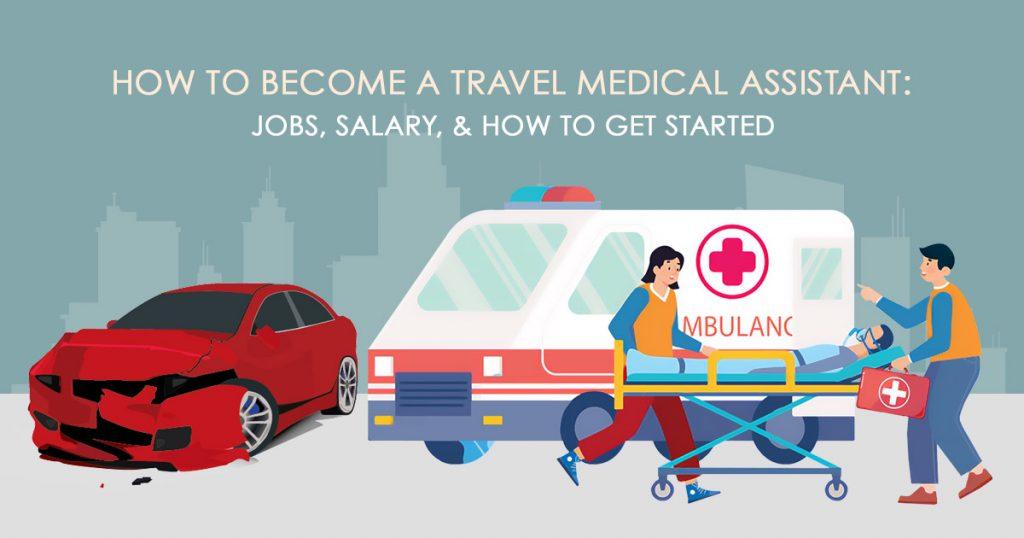Are you a healthcare worker who loves to travel? For many in the medical field, traveling isn’t just a fun escape—it’s a way to recharge from the pressures of their demanding jobs. Studies show that nearly half of healthcare professionals face burnout, making time to relax and unwind essential.
But what if you could merge your passion for helping people with your love for adventure? That’s exactly what being a traveling medical assistant offers. It’s a chance to continue your career while exploring new places, meeting different people, and experiencing life in exciting ways—all while making a difference in the lives of others.
What is a Medical Assistant vs. Travel Medical Assistant Job?
Medical assistants are essential in healthcare. They help with both clinical and office tasks, like checking patients’ vital signs, preparing exam rooms, helping with small procedures, scheduling appointments, and keeping medical records organized. They make sure everything runs smoothly in clinics and hospitals. Most medical assistants work in one place and have a steady routine.
A traveling medical assistant, on the other hand, has the same responsibilities but works in different locations. You might spend a few weeks in one city clinic, then move to a rural hospital for your next assignment. The biggest difference is the need to adapt quickly to a new workplace, coworkers, and rules—often with very little training.
What Makes It Different?
Being a traveling medical assistant isn’t just about having the right skills. You need to be flexible and ready to adjust to change. Good communication is important because you’ll meet new teams at every job. Physical stamina is also key since the job often means long hours on your feet and unusual schedules. To succeed, you’ll need to be open to adventure, new experiences, and a fast pace.
How to Become a Certified Travel Medical Assistant
If you love the idea of working and traveling, becoming a travel medical assistant can be a great choice. Here’s how to get started:
1. Finish High School or Get Your GED
First, you need to graduate from high school or pass the GED test. This is the basic requirement to begin your training. If you don’t have a diploma, you can join an adult education class or find online programs that help you prepare for the GED.
2. Complete a Medical Assistant Training Program
Next, you’ll need to join a medical assistant training program. Pick one that’s accredited by trusted organizations like CAAHEP or ABHES. These programs can either be online for flexible learning or on-campus for hands-on training. Certificate programs usually take less than a year, while associate degrees take about two years. Don’t forget to check out scholarships or financial aid options to help pay for the program.
3. Get Certified (It’s Optional but Useful)
While you don’t have to be certified, it can help you find better opportunities. You can become a Certified Medical Assistant (CMA) or a Registered Medical Assistant (RMA). These certifications show employers you’re skilled and professional. To prepare for the exams, you can use practice tests and study materials that focus on topics like anatomy and medical laws. Remember, certifications need to be renewed regularly to stay valid.
4. Gain Work Experience
Most travel medical assistant jobs want you to have at least two years of experience in a regular healthcare setting. Clinic or hospital jobs are good places to start. These roles will help you improve your skills, learn patient care, and handle medical tasks. Asking for feedback and observing experienced coworkers can also help you grow. If you focus on areas like pediatrics or geriatrics, it may make you more attractive to employers.
5. Work with a Medical Staffing Agency
Staffing agencies can match you with travel assignments that suit your skills. Start by looking for well-reviewed agencies online. Update your resume to include your training, certifications, and work experience. Share your preferences, such as where you’d like to travel, your availability, and the kind of work you enjoy. Many agencies provide extra help with housing and travel arrangements.
6. Build Travel Skills
Travel medical assistants have to adjust to new locations and schedules often. Being flexible will help you fit into different workplaces. Keep yourself organized by using planners or apps to manage your assignments and travel plans. Make it a habit to communicate clearly and work well with new teams, as this will help you settle in quickly.
7. Be Prepared for Last-Minute Changes
Travel assignments sometimes come up with little notice, so staying prepared is important. Keep a packed bag ready for quick moves and try to stay positive when adapting to new environments. Whether you’re working in a big hospital or a small clinic, each experience brings something unique. Learning extra skills like phlebotomy or EKG can also provide more job options.
Is Being a Travel Medical Assistant Worth It?
If you enjoy trying new things and working in different places, being a travel medical assistant could be a great fit for you. This job gives you the chance to take assignments in a variety of healthcare settings, such as hospitals, clinics, nursing homes, or even specialized care centers. You might help doctors with patient exams, take vital signs, prepare medical equipment, or handle office tasks like scheduling appointments. Each assignment is unique, so you gain a lot of experience and continue to learn as you go.
One of the big advantages is the pay. Travel medical assistants usually earn more than those who work in one location. On average, they make between $35,000 and $50,000 a year, depending on factors like how much experience they have, where they work, and which staffing agency they use. Many agencies also offer extra benefits such as free or discounted housing, travel allowances, and even bonuses. These perks can make the job even more rewarding financially.
